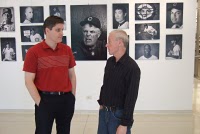 A few weeks ago, I had the privilege of interviewing Stephen Green, a fellow Oak Parker and the Chicago Cubs’ official photographer, for a segment to air on Oak Park’s Channel 6.
A few weeks ago, I had the privilege of interviewing Stephen Green, a fellow Oak Parker and the Chicago Cubs’ official photographer, for a segment to air on Oak Park’s Channel 6.
Through the end of the month at the Oak Park Public Library, Green has an exhibit of some 30 of the thousands upon thousands of photos he has taken since he began working with the Cubs in 1983. One is of Sammy Sosa listening to Barry Bonds as he discussed a hitting technique before the All-Star Game, circa 2004.
At the time, both had come under suspicion, to say the least, of having used illegal performance-enhancing substances to elevate their efforts. As Green and I spoke, I mused aloud if subsequent revelations of cheating somehow tainted the artistry of a photographer’s work.
Since my interview with Green, Sosa’s name has surfaced–to nobody’s surprise–as one of the 100-odd Major League players who tested positive for illegal performing-enhancing substance use in 2003, the same year he was caught using a corked bat.
Photograph Ain’t Tainted–Just Has a New Tone
Over the past several days, I have arrived at an answer to my question: the artistry of the photograph isn’t tainted, but it takes on a different tone–such as irony or tragedy.
The same is true for any writing related to those heady, naive times, such as my development of a baseball statistic, the Home Run Power Ratio, that was featured in an October 1999 issue of Sports Illustrated.
Just as it’s impossible to undo a photograph from its place and time, it’s far-fetched to think that anyone could re-calibrate statistics by weeding out cheating, which comes in so many forms, both blatant and subtle.
Related Posts:
Reunion with Fellow Beat Reporter Rekindles Wistful NU Bowl Game Coverage Hopes
From Deja Vu Despair to Unhinged Delight: Witnessing the Cubs Win the World Series
